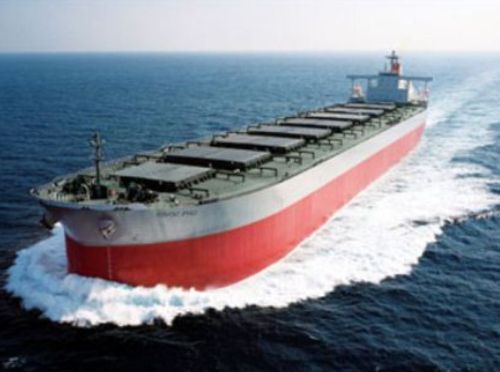
Mitsui Engineering & Shipbuilding Co., Ltd. (MES) completed and delivered 177,000 dwt type bulk carrier, M.V. “CAPE CELTIC” (MES Hull No. 1732) at its Chiba Works on 29th September, 2011 to “K”LINE BULK SHIPPING (UK) LIMITED, United Kingdom.
This ship is the 8th ship of the Cape-size Bulk Carrier of Dunkerque-max Type having a double-side skin to cargo holds construction. It enables effective cargo handling, easy maintenance of cargo holds and structural safety.
Cape-size Bulk Carrier of Dunkerque-max type:
A common name for the Cape-size Bulk Carrier accommodated to the restriction of the port of Dunkerque, France.
Principal Particulars:
Length overall 292.00 m
Length (between perpendiculars) 282.00 m
Breadth (molded) 44.98 m
Depth (molded) 24.70 m
Gross Tonnage 92,249
Deadweight 178,342 metric tons
Main Engine MITSUI-MAN B&W Diesel Engine 6S50MC-C x1set
Maximum Continuous Output 18,660 kW x 91 rpm
Speed 15.3 knots
Complement 28 persons
Classification Society NK
Port of Registry Panama
Date of Delivery September 29, 2011
Special Features:
In spite of cargo holds bounded by a double-side skin according to SOLAS, the cargo capacity of the ship is equivalent to that of conventional Cape-size bulk carriers with holds bounded by a single-side skin.
The ship was designed in accordance with IACS URS25 so that loading flexibility has been secured and structural safety has been improved.
Suitable arrangement of means of access required by SOLAS enables safe and effective inspection in cargo holds and ballast tanks.
Improvement of safety has been achieved by installation of a forecastle and by application of new requirements concerning reserve buoyancy to the ship.
Main Engine of the ship is MITSUI-MAN B&W Diesel Engine 6S70MC-C, which satisfies IMO Environment Standards for Exhaust Gas and achieves improvement of fuel saving by optimum matching at normal service output. An electronic controlled cylinder oiling system is applied to the main engine achieving operational cost saving.
Fuel oil tanks comply with MARPOL regulation on oil fuel tank protection to prevent marine pollution.
Ballasting and de-ballasting work can be efficiently made by separation of topside tank and bottom side tank.
We use cookies to improve your experience. By continuing to use our site, you accept our Cookies, Privacy Policy,Terms and Conditions. Close X